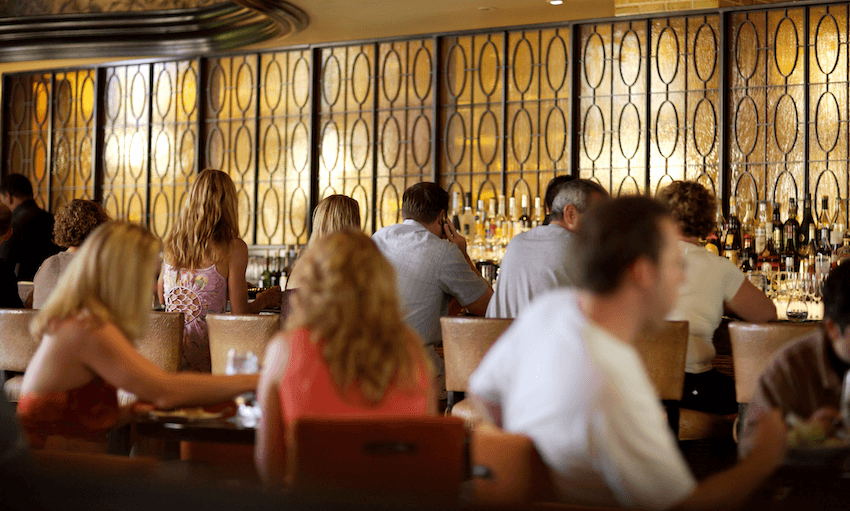Still unsure about what you need to do in restaurants and bars under level two? You’re not alone, according to a new Spinoff-commissioned survey.
Ongoing confusion around the use of mobile apps for contact tracing and social distancing in restaurants means New Zealanders and business owners still have work to do to correctly follow Covid-19 restrictions, according to a new survey.
Contact tracing forms and pens have become almost ubiquitous in the country’s bars and restaurants, but only about half of New Zealanders report using them in a survey conducted by Stickybeak for The Spinoff. While many of the rest reported using mobile tracing apps, such technology often doesn’t replace the need to give each hospitality establishment you visit your details with an old fashioned scribble.
The findings show that the majority of New Zealanders and businesses are trying to abide by coronavirus restrictions and contact tracing requirements, but many are falling short.
The government’s level two rules for the hospitality sector are that businesses serve groups of 10 or fewer at a single table, at least one metre from the next table, and use only one server per group. As of this Friday, groups can grow to 100 as the country significantly loosens Covid-19 rules.
Of those who had visited a hospitality establishment since the start of level two, only 54% reported that they were served by one staff member as required by the government at bars and restaurants. Nearly 12% of more than 700 Spinoff readers who completed the survey reported they were served by three or more staff members.
Nearly 73% of people reported that they were served at a table by staff, as required under level two rules, while 7% said they were served at a bar or counter.
On a more positive note, nearly 87% of respondents said that their group was kept at least one metre from the next.
“Places that aren’t following these rules should be aware that it isn’t just to protect customers, but them and their staff. They probably should,” said Andrew Chen, a research fellow in computer systems engineering at the University of Auckland and an expert in personal tracking technology.
The survey results in full (hover over the arrows at the bottom to move through the slides)
In recent days much of the government’s focus has shifted to a new official contact tracing app, NZ Covid Tracer, designed to help New Zealanders keep track of where they’ve been in the country.
“All these rules at hospitality venues are methods to reduce risk, but none of them eliminate risk. That’s why we need contact tracing. At the end of the day if businesses keep good records of who has been there, they can contact everyone if someone with Covid-19 has been through,” added Chen.
There’s been considerable confusion expressed on social media and in hospitality venues since NZ Covid Tracer was released a week ago. Officials including director general of health Ashley Bloomfield have defended the app in recent days despite what has been perceived as a lack of functionality.
The app cannot yet automatically contact people if they’ve been near someone who tests positive for Covid-19. It also doesn’t automatically log people when they enter a restaurant, bar or other business. Bloomfield and prime minister Jacinda Ardern have taken to crediting the app for what it can do: not so much contact tracing, as contact harvesting for the Ministry of Health. Every person who registers on the app provides the government with up-to-date contact details.
“Even by registering, people are giving us, and only the Ministry of Health, their details,” Bloomfield said on Tuesday. He added that the health ministry has been trying to deal with a number of bugs that have been found, including by people who have emailed him personally about issues with the app.
Over 405,000 people have registered to use the government app and over 15,500 businesses now have QR code posters they can use. That’s about a quarter of the number of businesses the government says are currently active in the country.
Ardern also calls the government app a “digital diary”. New Zealanders are expected to keep track of everywhere they’ve been in recent weeks in case they test positive for Covid-19 and a contact tracer needs to retrace their footsteps.
While only 49.7% of respondents to the Stickybeak survey said they had left details with businesses on contact forms, a further 25.7% said they had scanned a QR code using one of a number of apps that are now available. Some of those apps might have functionality that allow businesses to keep track of who signed in, negating the use of the pen and form for those who have used the app. Only 12.6% said they used the government app, slightly more than the 12% who said they left no details by any means.
Ardern said on Monday she hopes more features will be added to the NZ Covid Tracer app in coming weeks that will see fewer people need to sign at the door of businesses. The pen and paper will need to remain indefinitely for people without smartphones.
“There’s a little bit of overlap at the moment around recording for hospitality. You still see that, some are still continuing to use other apps like Rippl and so on, but we do see a situation in the not-too-distant future where we can consolidate right down,” she said.
The Wellington-based company behind Rippl, which has been adopted by many businesses including councils, said yesterday it has now integrated the ministry’s official QR codes into its app.

